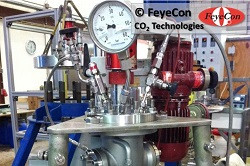Carbon dioxide could be turned into a commercially viable chemical
Turning carbon dioxide into a useful substance is not a new experiment. Many projects exist but they linger in the realm of academic research. Projects tend not to venture into creating a technology that can be scaled-up and become commercially feasible. But one project is hoping to bridge that gap. CYCLICCO2R has developed a valuable chemical from CO2 and is demonstrating its commercial feasibility. It has brought academic studies a step closer to industrialisation by assessing the potential of the process in industry on a commercial scale. The project hopes that its work will be taken further by industry or by a follow-up project. Moreover, it hopes to provide an important example of how CO2 can be used. Carbon dioxide can be reused to create cyclic carbonates. The two most widely used cyclic carbonates are ethylene carbonate and propylene carbonate, but more specialised cyclic carbonates, such as the one being developed by the project, also have high commercial interest. ‘Cyclic carbonates are important industrial chemicals with a variety of uses including environmentally-friendly solvents, lithium ion batteries, paints and coatings, resins and polymer processing,’ explains Erin Schols, CYCLICCO2R Project Coordinator. ‘They are often produced from the reaction of an epoxide and CO2 at high temperatures and/or pressures. However, recently discovered catalysts, such as those developed at the University of York and used in CYCLICCO2R, now allow for this reaction to take place at ambient conditions,’ Schols adds. The benefits include a reduction of CO2 emissions thanks to the use of more active catalysts, less energy-intensive process conditions and the use of bio-based feedstocks. ‘The process being developed in our project is applicable to a range of cyclic carbonates – some are currently used commercially, some not. With lower production costs and environmental benefits, the use of these specialised cyclic carbonates could see significant growth,’ she outlines. The project is currently evaluating how to move the process from laboratory to commercial scale. ‘This could present difficulties including the scale-up of the reactors themselves and the ability to make the catalyst on a large scale in a cost-effective manner,’ Schols explains. At this time, the project is still in a critical stage with the process moving from the laboratory to a mini-plant demonstration. If CYCLICCO2R can gain positive results from the demonstration and its subsequent analysis, its largest industrial partner may take the process further to full commercial implementation. While this project can clearly contribute to cutting CO2 emissions, it has other goals. ‘By showing that CO2 can in fact be used in an industrially relevant way, we hope to inspire more interest in developing these processes,’ Schols states. CYCLICCO2R also hopes to show how the use of fossil fuels as a feedstock for the production of chemicals can be cut by using bio-based feedstocks. This, in turn, would reduce the EU’s dependency on fossil fuel imports. ‘At the same time, we are working on improving the public perception of using CO2 to create a useful substance, in particular by developing an app which can be used by policy makers, the scientific community and the general public,’ she concludes.
Keywords
CYCLICCO2R, carbon dioxide, cyclic carbonates, fossil fuels, feedstocks, energy efficiency







